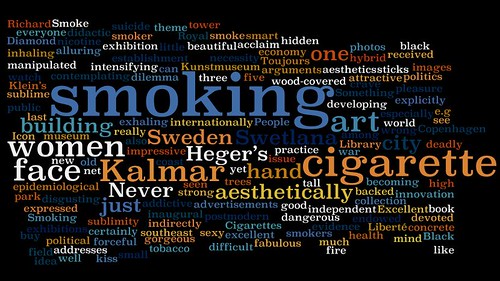Under the heading “Journals under Threat: A Joint Response from HSTM Editors” ten editors of some of the leading international journals for history and philosophy of science and social studies of science have issued a joint declaration against the current attempts, initiated by the European Science Foundation, to establish a European rating system for humanities journals (ERIH): Read More
Like many other blogs we here at Biomedicine on Display have a long list of (potentially) useful life science and health/medical blog links—all those sites which together constitute the hypertextual inspiration base for our web presence.
It would be great if these could be visualised as a blogroll cloud (like a tag cloud or a category cloud). So far I haven’t seen one, but last night, when I was playing with the new Wordle text cloud generator (see earlier post here), I used it to see what our blogroll would look like in cloud format.
First I created a cloud out of a net list of my 35 favourite blogs (using ~ between the words which is Wordle’s way of keeping words together in sentences):
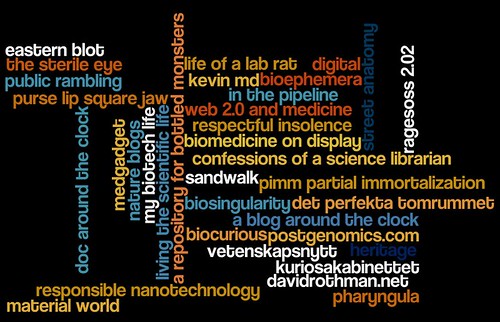
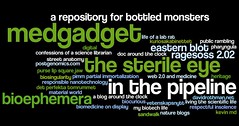 Then I manipulated the picture a little (literally manually!). By repeating the names of my most-favourite blogs 2, 3 or 5 times I could produce a weight-effect:
Then I manipulated the picture a little (literally manually!). By repeating the names of my most-favourite blogs 2, 3 or 5 times I could produce a weight-effect:
Both look great, I think! Much better than most blogrolls I’ve seen so far.
It’s still just a dummy, because at the moment Wordle cannot make the links clickable (or make the size of the blog names correspond to the number of times one had visited the blogs), but I’m sure Jonathan Feinberg (the software engineer who has designed Wordle) can find a solution to that problem with some hard code work.
Then I tried something else. I pasted the whole list of blogs without using the ~ character—i.e., all singular words in all names on our gross list—into Wordle’s input window. This procedure visualised like this:

and like this (Wordle has a huge reportoire of fonts, layouts and colours):

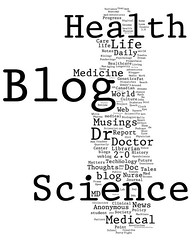
These word clouds looks nice too, but they are nevertheless disappointing because the gross blog list (below) contains many more words than those that Wordle processed into the single word clouds. For example, the words in Pimm: Partial Immortalization, Bioephemera, The Sterile Eye and many others aren’t there. Apparently, Wordle only accepts rather small chunks of text. Or maybe it has excluded singulars? (Added 21 July: Oops, I had overlooked the ‘maximum words’ function, thanks Jonathan for drawing my attention; see comment below).
Anyway, it’s a fun way of producing a visualised blogroll. And with some added functionalities (e.g., clickability) it could be turned into a useful WordPress widget.
Here’s the raw unassorted gross list (it has been accumulated over some time so there may be some dead links and other inaccuracies as well): Read More
The regulation of public health data collection and display is an interesting field of research for historians of contemporary public health. Here’s how I came to think about it:
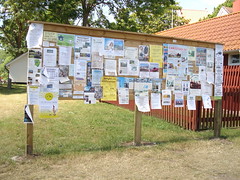 On our way back to Copenhagen from three days of vacation on the island of Öland off the coast of SE Sweden with its beautiful and peculiar landscape (especially the alvar heath), we took a short break in Kristianopel, once (in the early 17th century) an important and heavily fortified Danish border town, now a tranquil vacation resort.
On our way back to Copenhagen from three days of vacation on the island of Öland off the coast of SE Sweden with its beautiful and peculiar landscape (especially the alvar heath), we took a short break in Kristianopel, once (in the early 17th century) an important and heavily fortified Danish border town, now a tranquil vacation resort.
While Anna went down to the beach to take a swim in the Baltic Sea, I took a closer look at the local billboard where I found, among announcements for local flea markets and invitations to parties for young church-goers, an official report on the bathing water quality issued two days earlier by an accredited laboratory:

saying:
- E. coli: 0 mpn/100 ml, measured by the Colilert-18 method
- Intestinal enterococci: 13 CFU/100 ml, measured according to ISO 7899-2
Zero E.coli is fine, of course, but 13 CFU (colony forming units) of enterococci (common faeces bacteria) is not so good. Wikipedia informs me that the state of Hawaii accepts only 7 CFU/100 ml before posting warnings! The municipality of Karlskrona, however, concludes that the water quality is “tjänlig” (suitable).
I’m probably about the only person visiting Kristianopel who has ever cared to read, let alone understood, the water quality report. Regulations issued by the Swedish Environmental Protection Agency stipulate that local authorities must make such tests (see Naturvårdsverkets författningssamling 2008:8) and make them publicly available. But apparently the local authorities don’t have to announce the results in a way that makes sense to visitors to the beach—for example that the Kristianopel water is twice as bad as what they accept in Honolulu.
Well, Anna didn’t catch any nasty bugs and the rest is for the Kristianopolitians to consider further. But that said, I think their water quality report raises an interesting general issue. Ground-level ozone, pollen levels, etc. are heavily displayed on TV, in newspapers, etc.; for example, the National Museum of Natural History in Sweden issues a daily pollen prognosis report on the web. What other kinds of public health data are displayed in public? How are these data displayed? Through which media? And which are the political processes behind the decisions to have such data collected and broadcasted to the public?
In fact, the history of public health could be understood (cf. Dorothy Porter’s Health, Civilization and the State: A History of Public Health From Ancient to Modern Times, 1998; read a good review here) as the continuous political negotation of such data and their public display.
Everyone in southern Scandinavia interested in genetics and democracy should take the opportunity to attend a seminar series organised at the University of Lund in October through December. Dates and preliminary speakers include:
October 27
- A. Hedgecoe, Sussex: “The Politics of Personalised Medicine”
November 17
- A. Clarke, Cardiff: “Genes, Knowledge and Autonomy: Whose Knowledge? What Knowledge? When?”
- H. Gottweis, Vienna: “Operating Biobanks: Towards the Governance of Disappearing Bodies”
December 8
- L. Koch, Copenhagen: “The Politics of Life – past and present use of genetic knowledge”
- B. Wynne, Lancaster: “Genetic Risk – expert and lay perceptions”
More details later (or contact Niclas Hagen, Niclas.Hagen@svet.lu.se, for more info).
If you think the last post was too conventional, presentation-wise, try this word cloud version:
Generated by Wordle, a free service designed by Jonathan Feinberg, which allows you to create a word cloud from any text or url, and adopt a variety of fonts, layouts, and color schemes. See Jonathan’s blog here.
Nifty! Cannot handle pics though. Not yet — maybe next functionality? (Would be great to be able to make your own picture cloud).
Here’s another variety (the possibilities are endless):
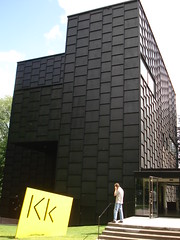 The city of Kalmar on the southeast coast of Sweden has just been endowed with a fabulous new art museum: Kalmar Konstmuseum—a tall, black, wood-covered concrete building hidden among the high trees in the old city park. Something like a hybrid between a postmodern fire watch tower and the Royal Library building in Copenhagen (the Black Diamond). The architectural innovation has received much acclaim, both in Sweden (e.g., here) and internationally (see last issue of Icon, not on the net yet)
The city of Kalmar on the southeast coast of Sweden has just been endowed with a fabulous new art museum: Kalmar Konstmuseum—a tall, black, wood-covered concrete building hidden among the high trees in the old city park. Something like a hybrid between a postmodern fire watch tower and the Royal Library building in Copenhagen (the Black Diamond). The architectural innovation has received much acclaim, both in Sweden (e.g., here) and internationally (see last issue of Icon, not on the net yet)

In my mind, the most impressive of the three inaugural exhibitions is Swetlana Heger‘s ‘Smoke (Liberté Toujours)’—five collages of small photos of women, each and everyone of them smoking a cigarette.
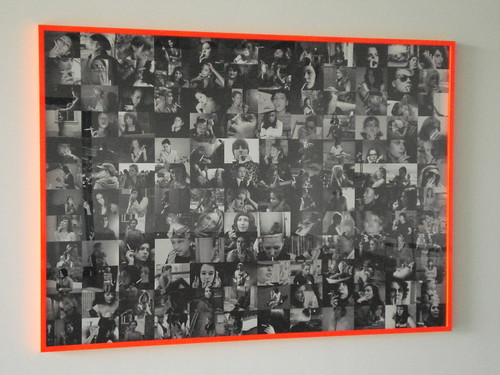
A face and a cigarette, a face and a cigarette, a face and a cigarette … hundreds of women: posing, contemplating, inhaling, exhaling.
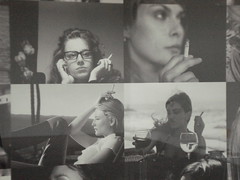 Never have I seen such a collection of images of beautiful, smart, independent, distinguished, alluring and gorgeous women devoted to the necessity of smoking. Never has the idea of the sublimity of the practice of smoking been expressed so manifestly in art. Smoking is most certainly addictive, disgusting and deadly dangerous. But it also aesthetically forceful. (This was the theme of Richard Klein’s excellent book Cigarettes are sublime, 1994).
Never have I seen such a collection of images of beautiful, smart, independent, distinguished, alluring and gorgeous women devoted to the necessity of smoking. Never has the idea of the sublimity of the practice of smoking been expressed so manifestly in art. Smoking is most certainly addictive, disgusting and deadly dangerous. But it also aesthetically forceful. (This was the theme of Richard Klein’s excellent book Cigarettes are sublime, 1994).
The aesthetics, economy and politics of smoking is a difficult field. On the one hand, the health-care establishment, backed by strong epidemiological evidence, has really good arguments for intensifying the war on smoking, especially in the developing world. On the other hand, millions of smokers cannot be wrong, can they? People don’t just smoke because they crave for nicotine or are manipulated by tobacco advertisements. If smoking wasn’t a pleasure—and an aesthetically attractive (at least if you don’t kiss the smoker) one as well—nobody would buy these sexy little suicide sticks.
Swetlana Heger’s exhibition in Kalmar addresses this dilemma indirectly without becoming didactic or explicitly political. Excellent public health art!
The BIOS Centre at the LSE is organizing a conference about the politics of the life sciences in an ‘age of biological control’, 16-18 September next year (i.e., 2009). The organisers are particularly interested in papers that Read More
Yesterday I wrote about my experience of visiting Le Laboratoire in Paris. In Chapter 6 of his recent book Artscience (2008) the founder, David Edwards, explains the background for his art-science center.
The son of a chemist, David was trained as a chemical engineer, then continued to graduate school where he did theoretical fluid mechanics. After his PhD in the 1980s he took up a postdoc in Haifa where the first Intifada opened his eyes to the world outside theoretical chemistry. He started creative writing as a side chore and in the 1990s he shared his time between MIT’s writing programme and working in Robert Langer’s (this year’s Millennium Prize winner) biotech lab on drug-delivery through aerosols. The lab work led to a paper in Science, in 1997, that suggested a new and better method for manufacturing and distributing drug particles.
Like so many other biotech researchers, David used his knowledge to start a biotech company. The aim of David’s company was to deliver insulin in the form of the new kind of aerosol. It apparently went very well, because only two years later he and his co-founders sold to a big pharma company, earning a lot of money (“the largest accrual of value at the time in biotechnology history”), giving David, his wife and his kids enough to realise some of their dreams.
Armed with this new and unexpected wealth, Read More
 Last august, we invited the founder of Le Laboratorie in Paris, David Edwards, to our workhop on ‘Biomedicine and Aesthetics in a Museum Context’. His presentation was short and (and at least to me) not very clear, so last time I was in Paris I took the opportunity to see his new art and science meeting spot.
Last august, we invited the founder of Le Laboratorie in Paris, David Edwards, to our workhop on ‘Biomedicine and Aesthetics in a Museum Context’. His presentation was short and (and at least to me) not very clear, so last time I was in Paris I took the opportunity to see his new art and science meeting spot.
Le Laboratoire is placed in a former film studio close to the Louvre in the heart of Paris. The exterior is non-assuming; you have to look for it to find it.
Inside/downstairs is a big room with a raw, industrial look. Texts explain this is a “center of experimentation in art and design based on the notion of art and science as process toward a creative end”. It is emphatically not a museum (it eludes “classical curatorial care”) but is about innovation—to “facilitate discipline crossing” and “catalyzing innovation” by means of “artscience, this ability to appreciate and develop an aesthetic and scientific sensibility”:
We work with highy creative artists and designers and seek dreams of idea translation that cannot be formulated without the participation of a leading scientist
Continuing the thread of thought in our art-science session at the SLSA meeting in Berlin in early June, I’ve just read David Edwards’s Artscience: creativity in the post-Google generation (Harvard University Press, 2008).
In Chapter 3 (“Idea translations in cultural institutions”), Edwards gives an interesting argument for bringing art into science and medical museums through the example of Wolf Peter Fehlhammer’s directorship of Deutsches Museum in Munich, the first and biggest science and technology museum in Germany, in 1993-2004.
As Edwards points out science museums and science centers have traditionally used art “to communicate the science message” in order to reverse the public skepticism of science. This was not Fehlhammer’s view of the art-science relation. Coming from a position as professor in chemistry at Freie Universität in Berlin “with a passion for the aesthetics of science” and with a belief that the future flourishing of science depends on “its ability to embrace the art of science”, he took another road when he was hired to head Deutsches Museum in 1993.
Fehlhammer wanted a science renaissance in the museum. In his own words, he wished to
reconcile people with the fascinating if challenging ‘Leonardo world’ [i.e., the world of contemporary science] around them. And, then, science might regain its former place, even reach new heights, and at the same time reestablish a social contract (p. 63).
This idea were realised in a number of events, including a Kunst-und-Wissenschaft programme, a laboratory for new electronic music, and several exhibitions. Fehlhammer’s favourite, says Edwards, was a performance art exhibit where artist Theda Radtke parodied a scientific lecture, showing how academic form takes over research substance. The art performance deconstructed the standardised rituals of science in order to remind the spectators about the original freshness, vulnerability, surprise and groping for truth that basically motivate most scientists to do science.
The idea was then not just to get art works as such into the Deutsche Museum. What concerned Fehlhammer, according to Edwards, was “how to engage artists to disrupt the way the public viewed science, how to empower artists within the museum … to challenge and disturb, to show the complexity of art and science and the dialog that must take place between the two” (p. 62). In other words, Fehlhammer wanted “to see art in the museum as provocateur” (pp. 59-60).
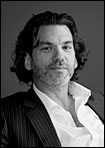 This is an interesting way of seeing the art-science relation in museums. In Fehlhammer’s vision, art should play the same role in science museums as it often does, or at least should do, in galleries and art museums, viz., to shatter our taken-for-granted views and understandings of the world. Accordingly, under Peter Fehlhammer’s directorship Deutsche Museum was partly turned into an art museum, and when the museum celebrated its 100th anniversary in 2003 “Fehlhammer received laudatory letters of congratulation from art museums all over the world” (p. 67).
This is an interesting way of seeing the art-science relation in museums. In Fehlhammer’s vision, art should play the same role in science museums as it often does, or at least should do, in galleries and art museums, viz., to shatter our taken-for-granted views and understandings of the world. Accordingly, under Peter Fehlhammer’s directorship Deutsche Museum was partly turned into an art museum, and when the museum celebrated its 100th anniversary in 2003 “Fehlhammer received laudatory letters of congratulation from art museums all over the world” (p. 67).
(In a later post I will get back to David Edwards’s idea of a ‘laboratory’ for “experiment, action, and movement in and between the arts and sciences” which he is creating in Paris right now.)

